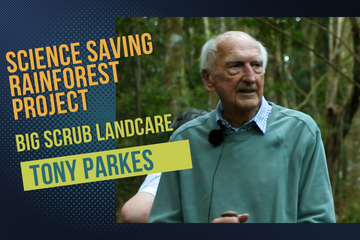The Q & A session of the Innovations in the Chemical Management of Vertebrate Pests webinar addressed the following questions from the audience. Q & A Timecodes 00:00 – 01:50 Might the lack of native plant recruitment after vertebrate pest control in sclerophyll veg communities be related to whether the soils are original or not? [...]
Innovations in the chemical management of vertebrate pests
Suzanne Pritchard2022-05-05T22:24:33+10:00Weed control is only one part of ecosystem management, animal pest management is another critical part of improving biodiversity outcomes. The 20 April webinar of the Chemicals In the Management of Biodiversity (CIMB) Working Group had two experts in the field of vertebrate control share the broad themes and detailed insights into chemical use of [...]

Tony Parkes – Science Saving Rainforest Project – Big Scrub Landcare (AABR AGM Guest Speaker)
Suzanne Pritchard2022-03-24T05:56:44+10:00Big Scrub Landcare are now driving an innovative program to ensure that all plantings use genetically diverse planting stock to overcome potential inbreeding and build greater adaptability to climate change within the landscape. Dr Tony Parkes (AO) - retired organic chemist and merchant banker (turned rainforest restorer) - is the Founder and President of Big [...]

Big Scrub Restoration – past, present and future
Suzanne Pritchard2022-03-24T05:58:52+10:00Dr Tein McDonald provides the background to the upcoming AABR Video on Heroes of Big Scrub Recovery and sets the scene for Tony Parkes talk on the Big Scrub Landcare's (BSL) Science Saving Rainforest project. Big Scrub was a once a 75,000 ha swathe of subtropical rainforest on the volcanic soils of the north coast [...]
Fire management business in Australia’s tropical savannas :: Jeremy Russell-Smith :: NCC Forum 2015
mitra2020-04-01T20:28:41+10:00The north Australian savannas are vast and have the potential to provide significant indigenous business opportunities for markets in greenhouse gas emissions, living tree biomass and non-living biomass as shown during the Carbon Farming Initiative. Jeremy Russell-Smith provides an overview of the fire management strategies that have been undertaken within the context of indigenous management [...]
Big Scrub – making a vision of genetically appropriate seed production areas a reality :: Tony Parkes :: SERA Conference 2018
mitra2020-04-01T20:28:42+10:00Rainforest restoration pioneers, Big Scrub Landcare, are again at the forefront of restoration ecology investigating solutions to the problem of genetic inbreeding in the hundreds of thousands of Big Scrub plantings. With the long term viability of the Big Scrub and associated investment at stake, they have developed a strategy to test for genetic diversity, [...]
Native seed production ‘farming for restoration supply’- Lessons from local and US sectors :: Paul Gibson-Roy :: SERA Conference 2018
mitra2020-04-01T20:28:42+10:00Why is grassy ecosystem restoration so hard…it doesn’t have to be? Paul Gibson-Roy shines the light on the USA’s approach. In 2015 Paul received a Winston Churchill fellowship to explore the industry in the USA .He shares his findings of the scale and viability of the industry and the government incentives and the structures that [...]
How ecological (ecocentric) restoration can help facilitate a nature conservation culture in Australia (Putting nature first) :: Todd Dudley :: :: SERA Conference 2018
mitra2020-04-01T20:28:43+10:00Todd explores the concept of ecocentricity and how it provides an ethical and social framework for both restoration and our relationship to the environment. An outline of the social, and individual benefits that have been produced on the Skyline tier project exemplifies how a changed worldview can unite a community. Todd, along with Michael Leunig [...]
Creating Waterponds to tackle the drought clay pans on the landscape :: Ray Thompson, Central West Local Land Services :: Broken Hill field trip 2017
mitra2020-07-08T15:06:21+10:00Arid landscapes that have lost their topsoil are subjected to erosive forces of wind and water to form a clay crust that prevents the growth of vegetation. Ray Thompson explains the technique of waterponding, which captures and directs water, slowing runoff and creating an environment for vegetation to reestablish. In the long-term wind erosion is [...]
Upping the ante on restoration-landscape scale restoration on Travelling Stock Reserves in the NSW Riverina :: Ian Davidson. Regeneration Solutions :: AABR Forum 2016
mitra2020-07-08T15:44:07+10:00The hidden world of Travelling Stock Routes (TSRs) comes to light as Ian Davidson explains their unique role across the Riverina landscape as a stronghold for biodiversity and threatened species. The absence of agricultural production techniques and fertilisers along with their location on flat fertile soils, linearly linked, has enabled the TSRs to remain prime [...]
